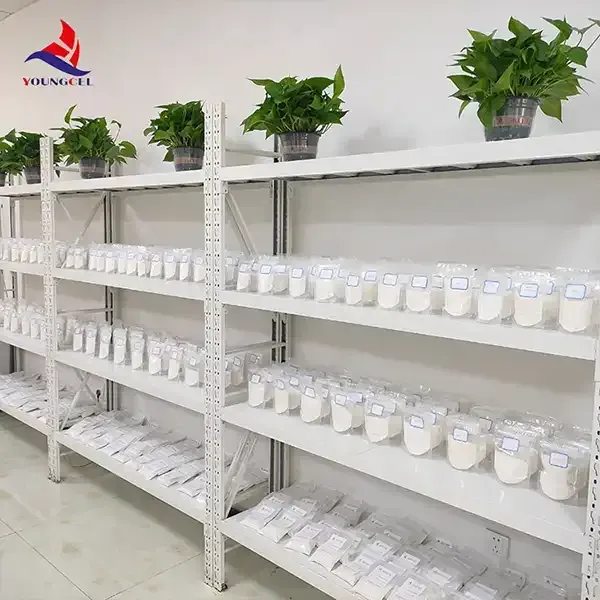Understanding Adhesive Methyl Cellulose A Versatile Polymer
Methyl cellulose, a derivative of cellulose, is a cellulose ether that has gained prominence across various industries due to its unique properties and versatile applications. With a chemical structure that allows it to dissolve in cold water, it forms a gel-like solution, making it an excellent choice for many adhesive and binding applications. This article delves into the characteristics, applications, and benefits of adhesive methyl cellulose, shedding light on why it has become a favorite among manufacturers and researchers alike.
What is Methyl Cellulose?
Methyl cellulose is obtained by the methylation of cellulose, a naturally occurring polymer found in the cell walls of plants. The process of methylation introduces methoxy groups into the cellulose structure, which alters its solubility and other physical properties. Unlike many other cellulose derivatives, methyl cellulose is unique in that it is soluble in cold water but becomes insoluble when heated, leading to a phenomenon known as thermal gelation. This characteristic is pivotal for many applications where control over viscosity and gel formation is desired.
Properties of Adhesive Methyl Cellulose
Adhesive methyl cellulose is known for its non-toxic, biodegradable nature, making it an environmentally friendly option compared to synthetic adhesives. Its adhesive properties stem from its ability to form strong hydrogen bonds with various substrates, allowing it to cling efficiently to surfaces. Other essential properties include
1. Excellent Viscosity Control Methyl cellulose can be adjusted to different viscosities, catering to specific requirements in applications ranging from construction to food processing. 2. Water Retention It retains moisture effectively, which is particularly beneficial in construction materials and cosmetics, where hydration is crucial.
3. Film-Forming Ability When dried, methyl cellulose forms a flexible film, offering protective and binding properties that are advantageous in various products.
4. Thermal Stability Its ability to withstand varying temperatures further adds to its versatility.
Applications of Adhesive Methyl Cellulose
The applications of adhesive methyl cellulose are extensive and can be seen across multiple industries
1. Construction In the construction sector, methyl cellulose is widely used in tile adhesives, joint compounds, and dry mortars. Its water-retaining properties enhance adhesion and workability, ensuring that building materials bond correctly and maintain their integrity over time.
adhesive methyl cellulose

2. Food Industry In the food sector, methyl cellulose serves as a thickening agent and stabilizer. It is commonly used in low-fat and gluten-free products to improve texture and mouthfeel while enhancing moisture retention.
3. Pharmaceuticals Methyl cellulose plays a crucial role in the pharmaceutical industry, primarily in drug formulation as a binder and coating agent. Its ability to control drug release rates is particularly valuable in the development of controlled-release medication.
5. Paper and Textiles Additionally, it is used in the production of paper and textiles, improving the strength and durability of materials.
Benefits of Using Adhesive Methyl Cellulose
The growing preference for adhesive methyl cellulose can be attributed to several benefits
- Eco-Friendly As a biodegradable product derived from natural cellulose, it aligns well with the rising demand for sustainable materials.
- Versatility Its adaptability in formulation allows it to be customized for various applications, making it an all-in-one solution for manufacturers.
- Cost-Effective Compared to many synthetic adhesives, methyl cellulose is often more affordable and can be produced using sustainable practices.
- Performance Its robust adhesive capabilities ensure reliability in bonding applications, reducing the likelihood of product failure.
Conclusion
Adhesive methyl cellulose stands out as a valuable polymer with extensive uses across various industries. Its unique properties not only enable it to function effectively as a binding agent but also make it an environmentally responsible choice. As industries increasingly shift toward sustainable practices, the demand for adhesive methyl cellulose is likely to grow, reinforcing its position as a vital component in the development of innovative products. Whether in construction, food, pharmaceuticals, or cosmetics, the versatility and efficacy of adhesive methyl cellulose ensure that it will remain an essential ingredient for manufacturers and consumers alike.
-
Rdp that The Revolutionary Polymer Powder Transforming Modern Construction MaterialsNewsAug.11,2025
-
Hpmc Powder that Versatile Additive for Detergents and Personal CareNewsAug.11,2025
-
Hpmc Hydroxypropyl Methylcellulose that Essential Building Material Additive from Shijiazhuang Gaocheng YongfengNewsAug.11,2025
-
Hydroxypropyl Methyl Cellulos Hpmc that Essential for Construction ApplicationsNewsAug.11,2025
-
Mhec Powder that Revolutionizing Construction Chemistry with Cellulose Ether SolutionsNewsAug.11,2025
-
Industri Hpmc that The Global Backbone of Advanced ConstructionNewsAug.11,2025




